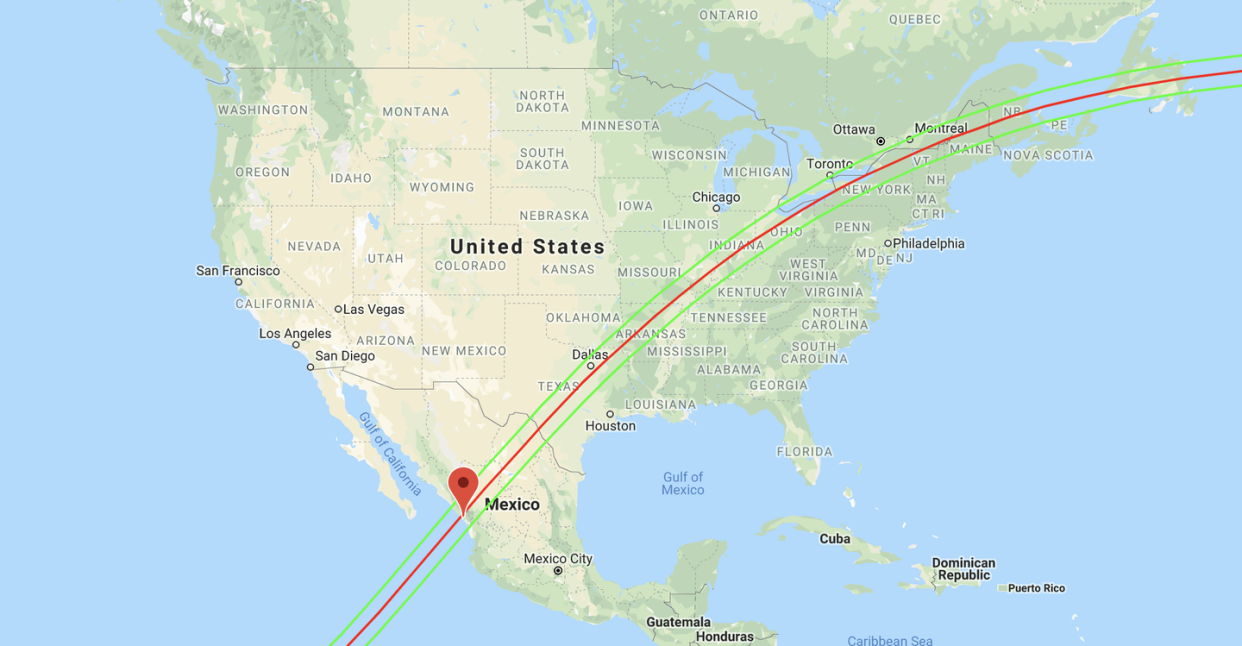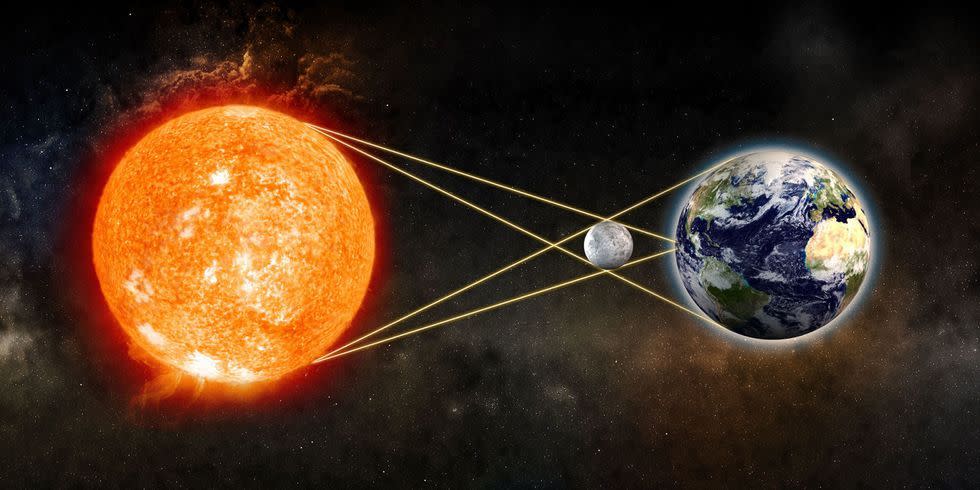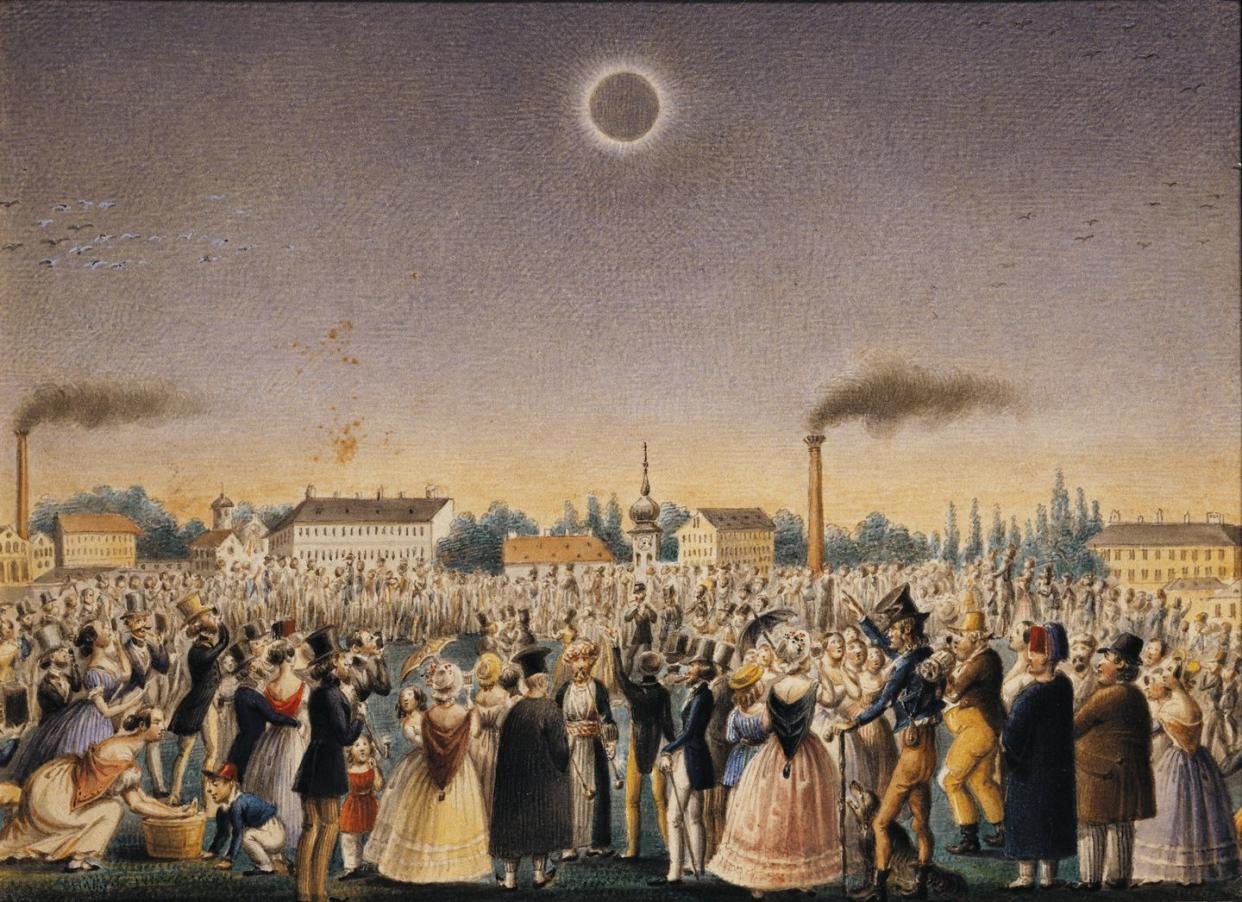What You Need to Know for the 2024 U.S. Solar Eclipse
"Hearst Magazines and Yahoo may earn commission or revenue on some items through these links."
Only seven years after its last solar eclipse (a pretty short time cosmically speaking), America will glimpse another total solar eclipse on April 8, 2024. One of the solar system’s great (and temporary) sights, it will be a chance to recognize humanity’s place in the universe and grab some pretty amazing stellar photography in the process.
With the main event only days away, here’s everything you need to know about the 2024 Total Solar Eclipse.
We’ll update this post as more information becomes available and as the date approaches.
Where Does the Eclipse Go? And When?

The eclipse will first become noticeable in Mexico, running through the states of Sinaloa and Coahuila before crossing the border mid-day and hitting Texas, passing through cities like Dallas, Waco, Forth Worth, and San Antonio, the ninth-most populous city in the country. While these cities won’t be directly under the eclipse, they’ll still experience a very noticeable darkness.
From there, the eclipse will continue its movement in a northeastern direction. A number of cities will be directly affected by the eclipse. To name a few, it will pass over Little Rock, Jonesboro, Cape Girardeau, Indianapolis, Dayton, Cleveland, Buffalo and finally Caribou, Maine, before it crosses into Canada.
On a state level, the eclipse will be passing through Texas, Oklahoma, Arizona, Missouri, Tennessee, Kentucky, Illinois, Indiana, Ohio, Michigan, Pennsylvania, New York, Vermont, New Hampshire and Maine.
Time and Date has a detailed map showing the full route, and Astronomy.com has compiled a list of eclipse times for major metropolitan areas in the path of totality. Be sure to consult the list to find and when and where you need to be.
What Will Be Happening, Exactly?

Let’s use Indianapolis, Indiana as an example. It’s been a long time since Indy has had a total solar eclipse—819 years, according to Butler University. Indianapolis will be very close to the center of what’s known as the path of totality. That path will be around 115 miles wide, with the direct center casting a shadow around 20 miles south of Indianapolis in Franklin, Indiana.
The Moon, moving around the Earth, will begin to block the Sun’s light starting at 1:50 PM. Solar eclipses occur when the Earth, the Moon, and the Sun are lined up. During the eclipse, the Moon is passing directly between the star and the Earth. All sunlight is temporarily blocked.
It won’t be very noticeable at 1:50 p.m., but the intersection between all three will grow over the course of an hour, and if it is a clear spring day, it will soon be unmissable. A darkness will fall over Indianapolis at 3:06 p.m., when the Sun will become totally eclipsed. The Moon will continue to move, getting closest to the Sun’s center a minute later at 3:07 p.m., reaching what astronomers call "totality." For three minutes, darkness will prevail with a glow of sunlight in the distance.
And then, at 3:09, it will be over. The total eclipse will hit its centers for a short period, nothing longer than five minutes. The Moon will continue to move, and by 4:23 p.m. the partial eclipse will have ended as well.
What Gear Do I Need?

First things first—you’re going to need to protect your eyes.
The first way to view the eclipse is indirectly using pinhole projection, and the website Time and Date has a step-by-step guide on how to make your own simple projector at home. You can also see the effects of the eclipse simply by looking at how light creates crescent shapes through the leaves of a tree or even through your own fingers.
Of course the most popular method is watching the eclipse directly, but you’ll definitely need eyewear that filters out the parts of the Sun’s spectrum that could damage your vision (these are some good options). This is no joke as damage to your eyes can take months or even a year to heal, and according to a new report by the The New York Times, some 2017 eclipse viewers are still suffering from visual impairment. So whatever you do, don’t skip this step.
If you want to fully document your eclipse experience, you’ll probably want to take some photos as the Moon traverses across the Sun. However, similar to the human eye, cameras shouldn’t be pointed toward the Sun for an extended period. Our step-by-step guide will walk you through the filters, techniques, and protections you need to take to capture every moment of the eclipse.
The video below, made in preparation for the 2017 eclipse, also walks through the finer points of snapping shots before, during, and after totality, and before the big day, take a few test shots of the Sun to make sure your setup is working properly.
How Can I Watch?
With the right gear in hand, you need to find the perfect place to watch this amazing solar display in all its glory.
Luckily there’s still time to make preparations, but finding a hotel room (especially one that’s reasonably priced) will be close to impossible. The New York Post reports that hotels in the path of totality are already charging 10 times the normal nightly rate. But because totality occurs in the afternoon for most parts of the U.S., it’s relatively easy to get to where you need to go from areas outside totality.
While the eclipse is swinging across a vast number of states and cities, it can be difficult to pinpoint exactly where to see the celestial display. The New York Times and the National Weather Service have historical cloud cover maps that shows the likelihood of a cloudy day during totality (hint: the farther south you go, the better your chances). As April 8th enters 10-day forecasts and beyond, be sure to consult local weather reports.
If having fun is higher on your list than a crystal clear day, Sky & Telescope has a detailed rundown of the many events occurring across the path of totality. And for a completely different kind of viewing experience, some airlines are offering eclipse-viewing flights so passengers can experience the entire stellar drama at 30,000 feet.
Of course, going in person can be a bit too cumbersome for the many millions who don’t live a comfortable driving distance from the totality zone. So similar to the 2017 eclipse, NASA will be putting on a livestream from 1pm to 4pm EDT as the Moon cuts a shadow across northern Mexico and makes its way toward Canada’s Atlantic coast. The broadcast will be chock full of Sun-blotting visuals as well as expert commentary and live demos.
But even when it comes to livestreams, you’ve got some options. The website Time and Date, for example, will be offering up its own livestream, and various research institutions will also be streaming the eclipse from the stratosphere via weather balloons as part of the Nationwide Eclipse Ballooning Project.
What If I Miss This One?
Missing the Great American Eclipse of 2017 is one thing, considering the next one was just seven years away. But missing the 2024 eclipse will be an entirely different matter.
The next eclipse after this one to shade American soil will be twenty years later on August 23, 2044, and that will fall on Montana and North Dakota as it mainly blocks out the Sun in Canada. So if you’re going to catch an eclipse in the U.S., the 2024 eclipse is your last opportunity for quite awhile.
Of course, if you’re not opposed to some world-traveling, then you’ve got lots of options.
You Might Also Like
